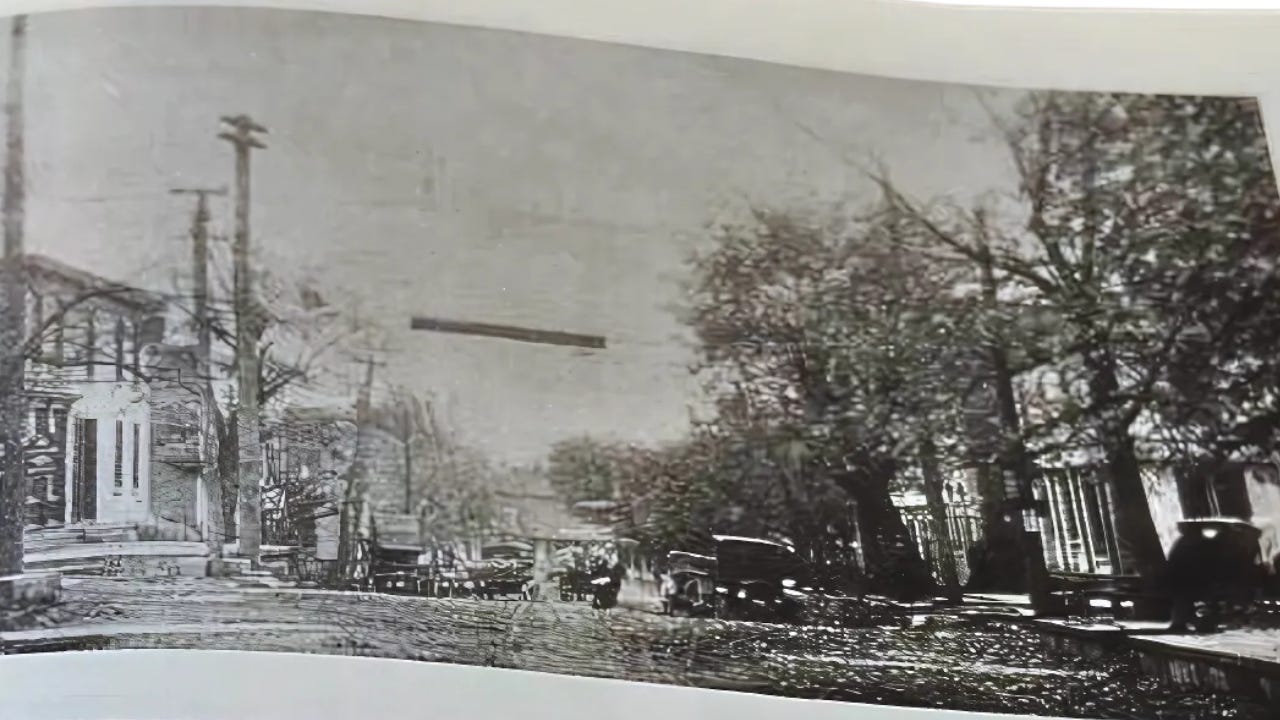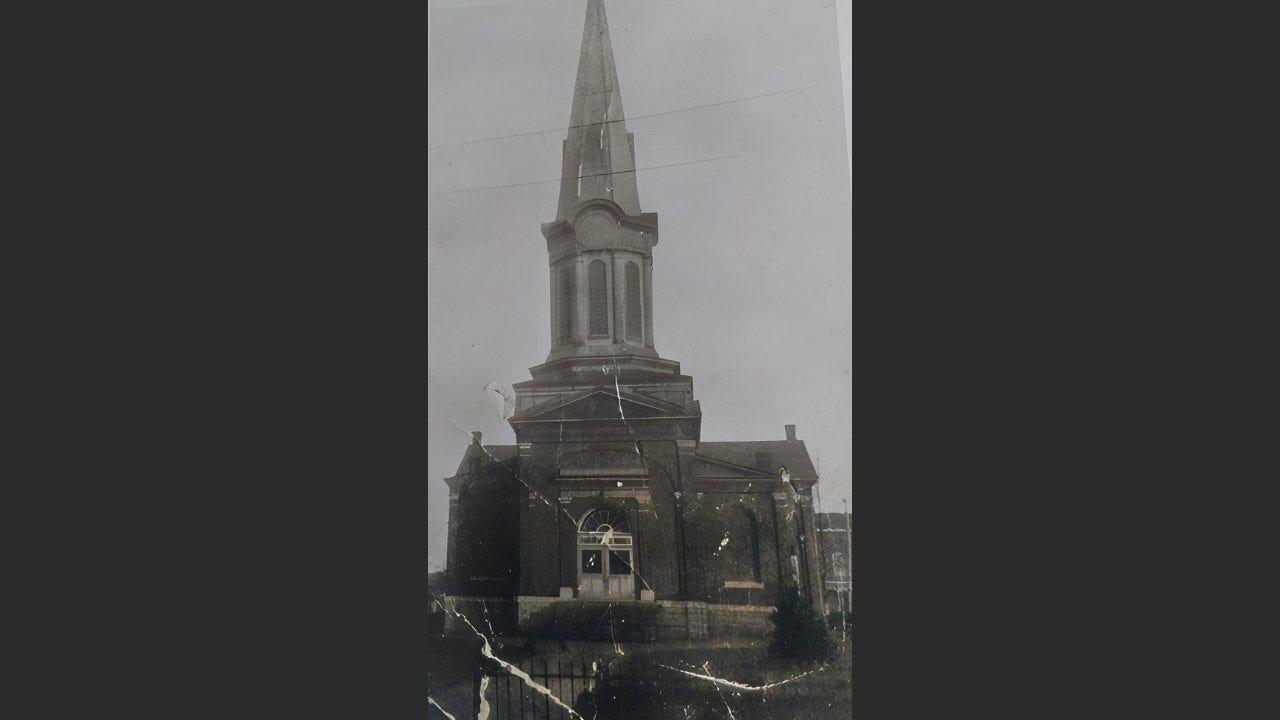The Priest in the Burning Church: A Story of Miraculous Courage
Remembering Catholic heroism in the small Kentucky town of New Haven
An old lady finished praying her Rosary. A husband filed into the pew after his wife. She held their newborn baby and rocked it softly as they waited for the Mass to begin. It was the early springtime of April 16th, 1928, and a brisk cold breeze followed the parishioners still coming inside the church. So crowded was this 7 a.m. Mass that those just now coming in could only stand.
The church, erected in 1886, was one of the grandest in the Kentucky Holy Land. Modeled after St. Peter’s Basilica, it served the railroad town of New Haven. Once the site of a Civil War battle, these were a hardy flock.
The Mass reached the point where Holy Communion is given out. Remember that this was the older form of the Mass and after Communion there was still much time before it concluded.
Even today, the people of St. Catherine of Alexandria are respected for their reverence during Communion. So then, I can only imagine the solemn silence there was when our ancestors approached to receive Our Lord.
Even more so, I can imagine the carefulness of the person who had to announce to the congregation in that moment that the church had caught fire on the outside. I do not know the name of this person, but I wager that their heart was beating fast yet held back with caution.
Perhaps it was the Nelson County Sheriff. We know that this Sheriff Boone Peake, “directed the exodus of the congregation, preventing a panic.” (The Catholic Telegraph tells us). It was likewise reported by the same newspaper that the “Ursuline Sisters led 50 children from the loft choir in perfect order.”
The parishioners, numbering around 800, walked out of the church still maintaining their dignity.

Reverend James H. Willett stayed at the altar with the strong heart of a captain still at the wheel of his ship amidst a terrible storm. Even after handing out Communion to all who had come forth, like a martyr, so fixated on Christ, though fear may have surrounded him, he was determined to finish the rest of the Mass. And finish the Mass he did.
Picture a young man startled by the commotion. He likely wouldn’t have been called a coward for leaving before the Mass had finished, yet he perhaps stayed for a moment longer. How could someone not be inspired and commanded by the zeal of Father Willett? Upon exiting, this young man had a desire to salvage whatever he could hold.
When it was over, the flames now burning much more intensely, this courageous Fr. Willett held Jesus tightly in His Arms. Fr. Willett walked with the Blessed Sacrament out of the sanctuary. With such love, he protected Him. Taking one last look at the beautiful dwelling place of God that had been his home and glancing forward at the last few remaining of his flock that he had a filial duty toward, Father Willett left the church of St. Catherine.
It is said that a few men who had went back in the burning church to rescue statues and other artifacts had “scarcely” left the building when the steeple, totally ablaze, came crashing through the roof. By the grace of God, none were harmed.
Firemen bravely put out the massive fire which had spread to two other houses. In the crowd that now filled the street, there may have been a few tears. What would be the reaction of a child in this moment? This remarkable church, which so many from this community had poured their efforts and humble lives into, was now in ruins.
The people of New Haven, Kentucky are a people who hold everything dear, especially the little things of life. What they may be lacking in manners, they make up for in Southern gentility. Even to this day, one can rarely pass by one of these country folk without an exchange of words of care. Their grandparents and kin certainly once held their Catholic faith near to their hearts.
Today, this fire is still talked about and remembered by descendants whenever it is recalled. It was never discovered what sparked it. A rumor developed that it may have been malicious, but perhaps time now gives the final benefit of the doubt.
One things is certain: Our ancestors had an ability to persevere. The same day of the fire, the other Masses of the day were soon being celebrated in the St. Catherine High School Auditorium.
The enduring lesson of the tragedy of St. Catherine’s church can be found in the words of our Founding Father, Bishop Flaget, who once contemplated what his reaction to the destruction of his St. Joseph’s Cathedral would be.
“Monsignor Flaget was still in Rome when he received a distressing letter. A horrible fire had partly devoured the buildings of his college in Bardstown…then he added: "It was too late to say: O my God! turn away from me this misfortune; but at least, I cried with submission: Dominus dedit, Dominus abstulit, sit nomen Domini benedictum (The Lord gave to me, the Lord has taken away, blessed be his holy name! Job 1:21). Oh! how happy one is to believe in Jesus Christ, and even more to love and imitate him! If, in informing me of the fire at the college, it had been added that the cathedral and the seminary, which are only a hundred feet away, had also been devoured by the flames, the chalice, doubtless, would have been much more bitter; still it would have been necessary to drink it, and, following the example of my divine master, I hope that I would have done so, and that like him I would have said: non mea voluntas, sed tua fiat (Your will be done, not mine. Luke 22:42)."
Letter of March 25, 1837. This passage is from 1851s Monseigneur Flaget, évêque de Bardstown et Louisville by Amédée Desgeorge (translated into English):

(An excerpt from 1971s Historic Nelson County, Sarah B. Smith)
ST. CATHERINE'S CHURCH, THAT WAS DESTROYED BY FIRE APRIL, 1928
St. Catherine's Roman Catholic Church was destroyed by fire as Mass was being celebrated and had just reached the point where Holy Communion was given. There was only standing room in the church when Sheriff Boone Peake announced that the building was on fire and the people must vacate.
The congregation walked out only one remaining and that was the Reverend James H. Willett, the pastor, who was at the altar and there he stayed until he completed the Mass.
When he left the altar, he carried the Blessed Sacrament with him.
In the meantime men saw that they could salvage certain things and went back into the church and carried out statues of the Blessed Virgin and St. Joseph, the Sacred Heart, Guardian Angel, St. Francis, Joan of Arc and John the Baptist and the main altar with the “Corpus Christi” [as well as] the Blessed Virgin receiving the body of Christ in her arms. The statues of the “Crucifixion” and the Resurrection were destroyed. Possibly half the pews were saved together with the Communion rail.
The organ was destroyed. The organ was made in Milwaukee, Indiana, and was possibly the first instrument in the state made so that the organist would sit with his or her back to the instrument while playing it.
The altars of the Blessed Virgin and St. Joseph, hand carved, burned. The building was a monument to the Reverend A. Viala who had been pastor here.
The stone foundation was the work of John and James Daisy of Lebanon and was about finished when the cornerstone was laid by the Right Reverend William George McClosky, Bishop of Louisville, on Sunday May 4, 1884. The consecration took place in 1886 at the time the big bell was blessed.
The church was Roman in architecture and was designed by Abbot Edward, former Abbot of Gethsemani.
The church was a cruciform easily showing the cross made by the main aisle and sanctuary with the right and left wings.
While the naves on each side together with the very large pillars and the side altars illustrated the Mystery of the Blessed Trinity making three churches in one.
The architects were McDonald Bros, and D.X. Mupily of Louisville, Kentucky.
The architect in charge of the erection was Baker Smith of Bardstown, Kentucky.















